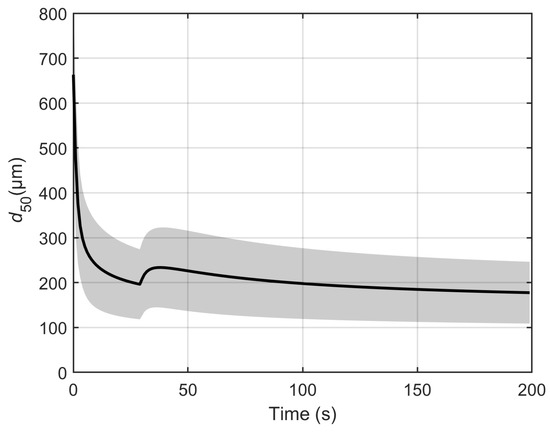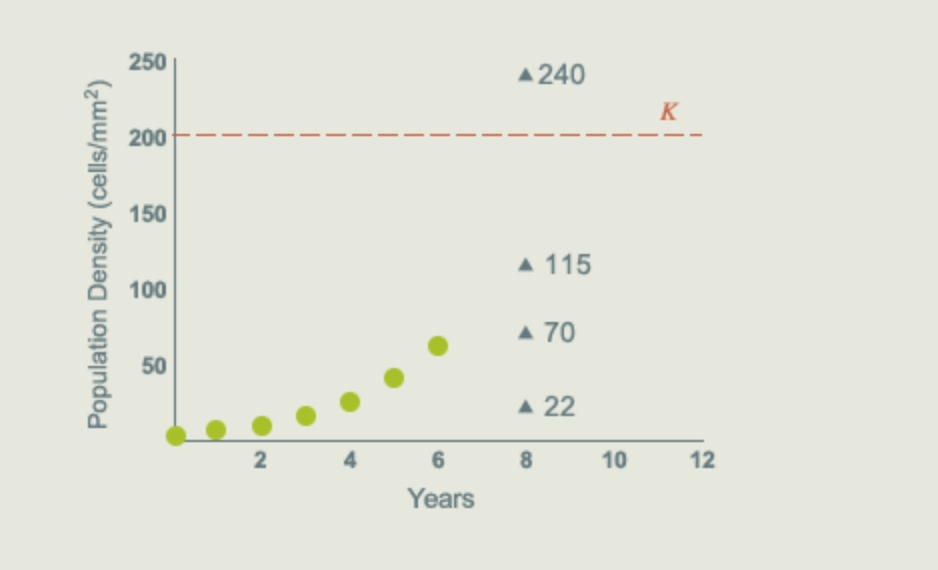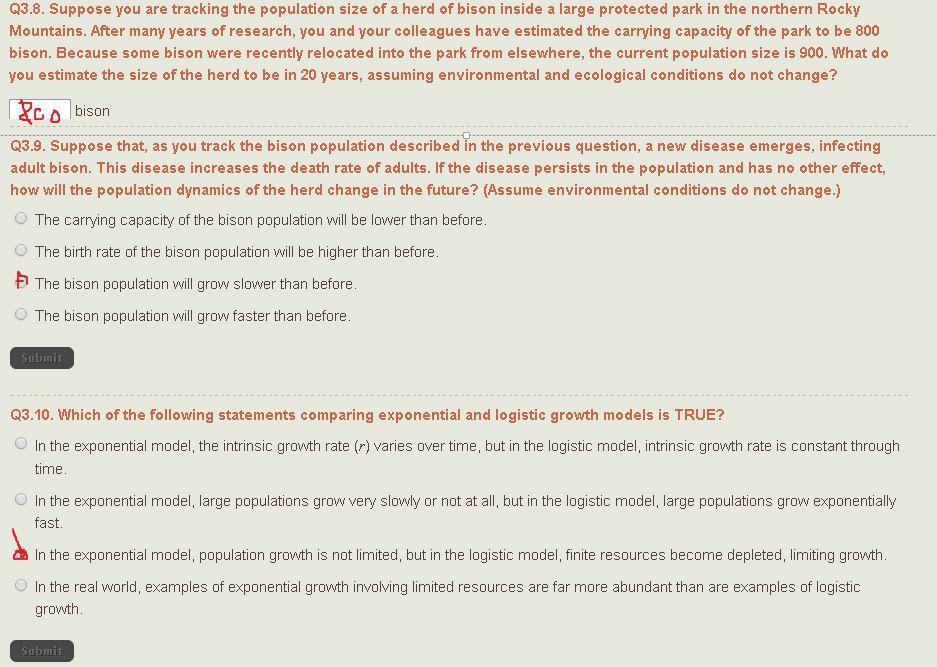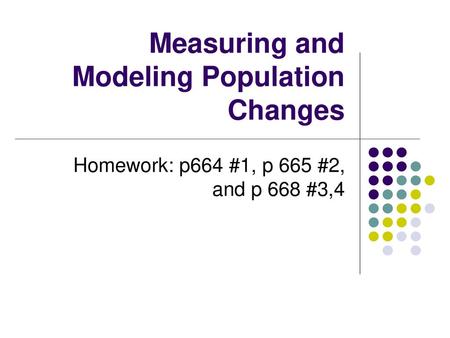If You Were Modeling the Growth of the Algae Population
This is due to bulk algal biomass which blocks light from reaching into deeper water. See answer 1 Best Answer.

Density Dependent Modeling An Overview Sciencedirect Topics
It will be what we compare the other experimental tubes to at the end of the week to know how much algae we could have had if not for the poisonous chemical.
. Its represented by the equation. The beginning cell density for the algae was 110 10 cellsmL. Assume that nutrient and sunlight input rates do not changeThe algae population would grow slower in this new environment.
Logistic growth produces an S-shaped curve. Chegg survey fielded between April 23-April 25 2021 among customers who used Chegg Study and Chegg Study Pack in Q1 2020 and Q2 2021. In nature population size and growth are limited by many factors.
What would you estimate the algae population density will be in two more years at year 8. You might not know it but a lake without algae would be a very dull place. To prevent or restore an unbalanced ecosystem its important to tackle algae-related issues.
If there were no algae there would be no small animals feeding on the algae and there wouldnt be any fish eating the small animals that eat the algae. Naturally the increase in algae would mean more potential for fish to. The intrinsic growth rate r is higher in year 6 than in year 20.
N is less than K If you were modeling a salamander population growth with the logistic equation you would assume that after many years the population growth rate dNdt would be close to zero and the population size would not. The control is simply the algae growing alone. The intrinsic growth rate r has decreased to approximately zero.
As John douma has mentioned in the comments you have to use the continuous model. 250 Population Density cellsmm 4 240 200 150 4 115 100 4 70 50 A 22 12 6 10 Years Q37. If you were modeling salamander population growth with the logistic equation you would assume that after many years the population growth rate Writ would be close to zero and the population size would not change much.
Some are density-dependent while others are density-independent. Ptkcdot Pt fracdPdtkcdot Pt. The carrying capacity of the algae population in this new environment would be lower.
240 115 70 22 submit 038. The data table below gives the growth rate for each test tube after one week. This is because after many years.
Calculate the final algae. The intrinsic growth rate r is lower in year 6 than in year 20. If you were modeling salamander population growth with the logistic equation you would assume that after many years the population growth rate dNdt would be close to zero and the population.
A par- ticular algal strain was grown in a glass dish indoors at temperatures ranging from 10 to 32. Light also has an effect on the growth of algae. In order to identify what factors contribute to maximum algae growth we must observe the human land use in various locations and the algae populations that grow in those locations while also monitoring growth to ensure detrimental overgrowth.
The Journal of Applied Phycology December 1994 published research on the seasonal growth activity of algae in an indoor environment. These so-called algal blooms deplete oxygen in water release toxins and cause. If you were modeling salamander population growth with the logistic growth equation during the first few years.
Density-dependent limiting factors cause a populations per capita growth rate to changetypically to dropwith increasing population density. 2If you were modeling the growth of the algae population according to the logistic growth model what would be different between year 6 and year 20. 2If you were modeling the growth of the algae population according to the logistic growth model what would be different between year 6 and year 20.
One example is competition for limited food among members of a. The algae population would grow slower in this new environmentThe algae population would grow faster in this new environmentThe carrying capacity of the algae population in this new environment would be lowerThe birth rate of the algae population would increase in this new environment. You might conclude that since some algae is good more algae is even better but algae growth has a down side.
High temperatures combined with stagnant water and nutrient overload usually results in excessive algae growth. Algae blooms usually occur in freshwater or marine water bodies. Was regressed against temperature x using the quadratic model Ey β0 β1x β2x2.
It must not be too strong or weak. Logistic growth takes place when a populations per capita growth rate decreases as population size approaches a maximum imposed by limited resources the carrying capacity. The algae population would grow faster in this new environment.
In most algal growth cultivation algae only need about 110 of direct sunlight. The daily growth rate y. The intrinsic growth rate r is higher in year 6 than in year 20.
Respondent base n745 among approximately 144000 invites. First of all we solve this differential equation by the method of Separation of variables. Algae can be found growing in various conditions or locations and are used for practical means such as biofuels or animal products.
Assume that nutrient and sunlight input rates do not change. Refer to the equation for the logistic growth model if you were modeling salamnder population growth with this logistic growth equation during the first few years a NK d there is no relationship between N and K. Ptkcdot Pt where Pt is the population of the algae cells.
On average a salamander has four offspring per year and lives for one year. N K N K N K. If you were modeling salamander population growth with the logistic growth equation during the first few years.
Growth rate of algae. Individual results may vary. Exponential growth produces a J-shaped curve.
Use the triangular markers on the graph to help you answer. In most water systems light only penetrates the top 7-10 cm of water. The birth rate of the algae population would increase in this new environment4Which graph represents.
Here population density can be modeled in the same manner as population size. Mixing is another factor that influences the growth of algae. If you were modeling salamander population growth with the logistic growth equation during the first few years.
Q4 a Steve Benner and colleagues are interested in designing nucleobases with non-natural hydrogen bonding patterns. The intrinsic growth rate r is lower in year 6 than in year 20. Ο Ν Κ N K NK There is no relationship between N and K.
Survey respondents up to 500000 respondents total were entered into a drawing to win 1 of 10 500 e-gift cards.

Processes Special Issue Recent Advances In Population Balance Modeling

Answered Ou Are Studying The Population Dynamics Bartleby

The Eco Evolutionary Modelling Of Populations And Their Traits Using A Measure Of Trait Differentiation Sciencedirect

Exponential And Logistic Growth In Populations Video Khan Academy

Lotka Volterra Model An Overview Sciencedirect Topics

The Eco Evolutionary Modelling Of Populations And Their Traits Using A Measure Of Trait Differentiation Sciencedirect

Carrying Capacity An Overview Sciencedirect Topics

Sg Docx Name Destiny Ibarra Date 09 16 2020 African Lions Modeling Populations Assessment 1 When Yellowstone National Park Was Created In The Course Hero

Ecology Icons Biology Classroom Teaching Ecology Teaching Biology

The Eco Evolutionary Modelling Of Populations And Their Traits Using A Measure Of Trait Differentiation Sciencedirect

Solved Hello I M Unsure About My Answers Based On An Chegg Com

Lotka Volterra Model An Overview Sciencedirect Topics

Population Ecology Logistic Population Growth Britannica

Changes In Population Size Population Dynamics Populations Always Changing In Size Deaths Births Main Determinants Measured Per Unit Time Natality Ppt Download


Comments
Post a Comment